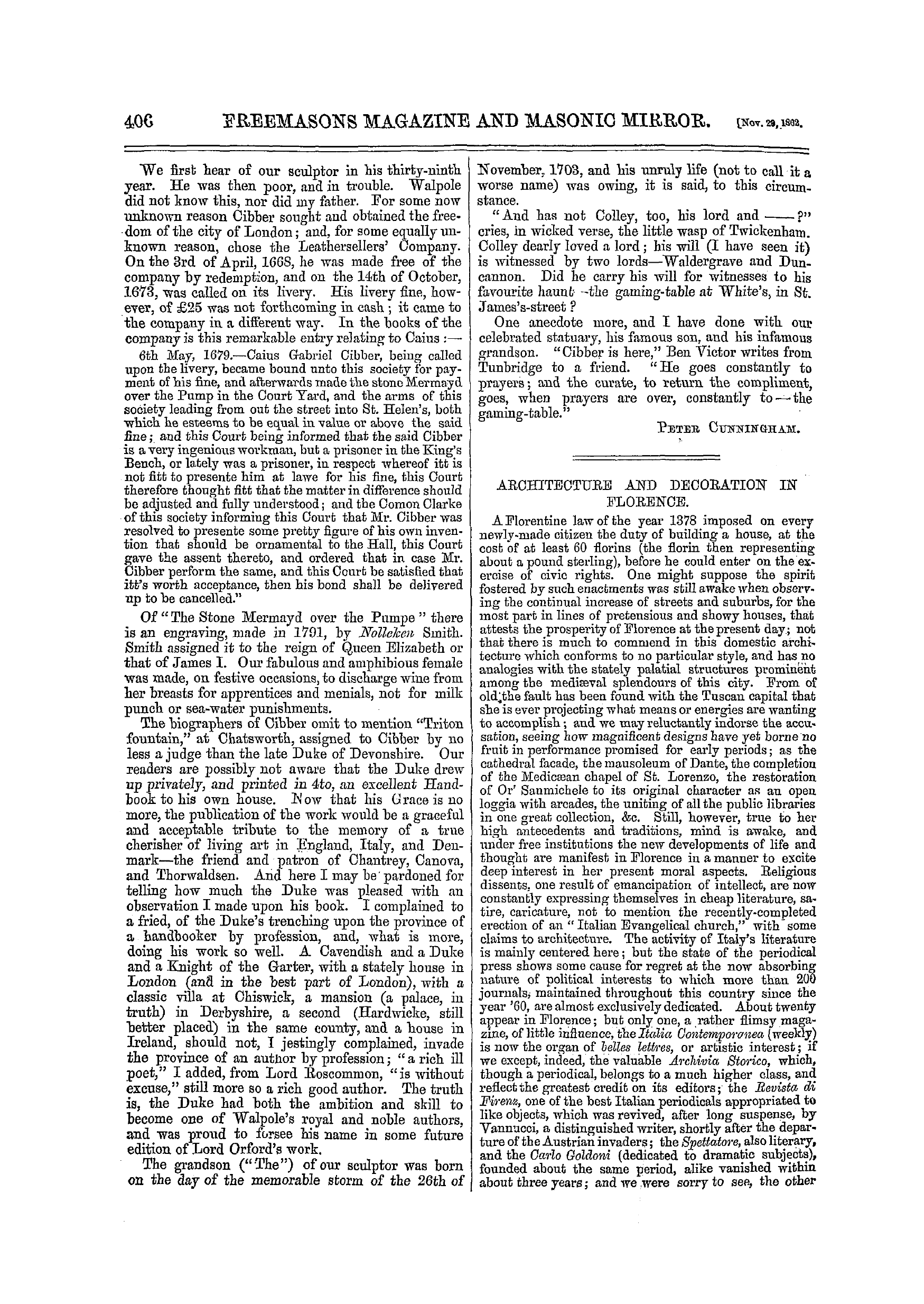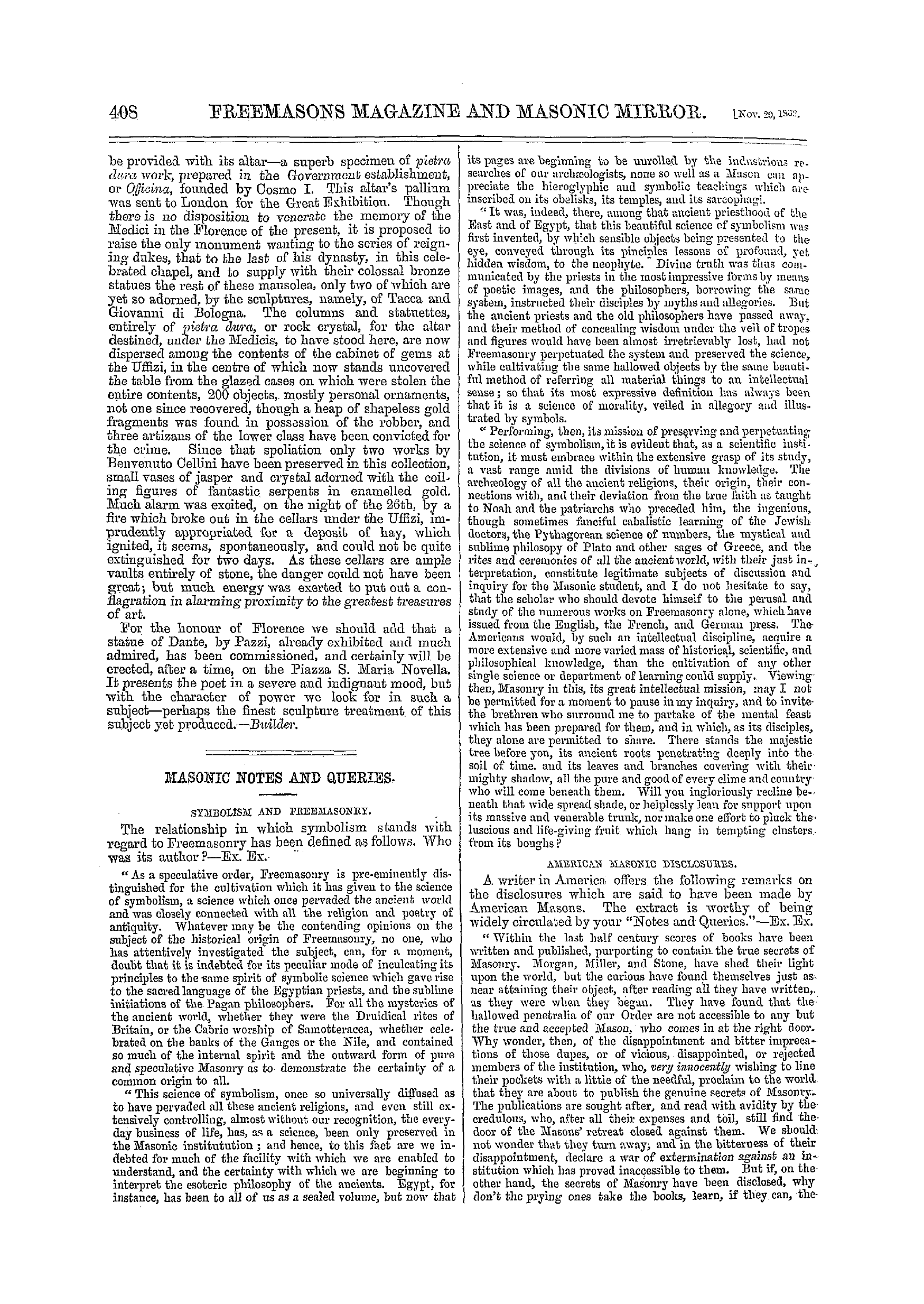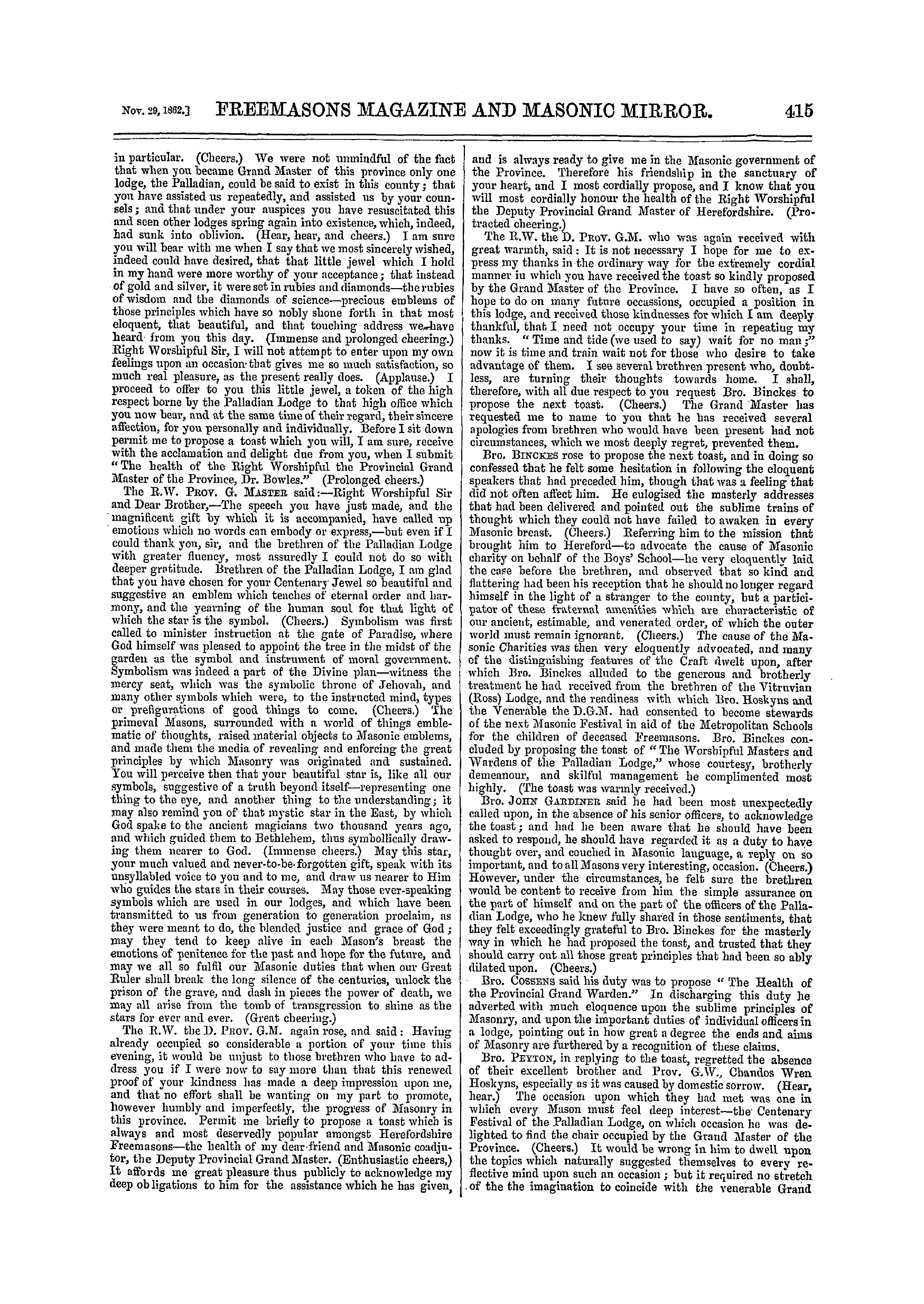Note: This text has been automatically extracted via Optical Character Recognition (OCR) software.
New Materials For The Life Of Caius Gabriel Cibber.
We first hear of our sculptor in his thirty-ninth year . He was then poor , and in trouble . Walpole did not know this , nor did my father . For some UOAV unknown reason Cibber sought and obtained the freedom of the city of London ; and , for some equally unknown reason , chose the Leathersellers' Company . On the 3 rd of Aril 1668 he was made free of the
p , , company by redemption , and on the 14 th of October , 1673 , was called on its livery . His livery fine , however , of £ 25 was not forthcoming in cash ; it came to the company in a different way . In the books of the company is this remarkable entry relating to Caius : —¦ 6 th May , 1679 . ' —Caius Gabriel Cibber , being called
upon fche livery , became bound unto this society for payment of his fine , and afterwards made the stone Mermay d over the Pump in the Court Yard , and the arms of this society leading from out the street into St . Helen ' s , both which he esteems to be equal in value or above the said fine ; and this Court being informed that the said Cibber is a ingenious workmanbufc a prisoner iu the King ' s
very , Bench , or lately was a prisoner , in respect whereof itfc is not fitt to presente him at lawe for his fine , this Court therefore thought fitt that the matter in difference should be adjusted and fully understood ; and the Comon Clarke of this society informing this Court that Mr . Cibber was resolved to presente some pretty figure of his own invention that should be ornamental to the Hall , this Court
gave the assent thereto , and ordered that in case Mr . Cibber perform the same , and this Court be satisfied that itt's worth acceptance , then his bond shall be delivered up to be cancelled . "
Of " The Stone Mermayd over the Pumpe " there is an engraving , made in 1791 , by NoTleJcen Smith . Smith assigned it to the reign of Queen Elizabeth or that of James I . Our fabulous and amphibious female was made , on festive occasions , to discharge wine from her breasts for apprentices and menials , not for milk punch or sea-water punishments .
The biographers of Cibber omit to mention "Triton fountain , " at Chatsworth , assigned to Cibber by no less a judge than the late Duke of Devonshire . Our readers are possibly not aAvare that the Duke dreAV up privately , and printed in 4 to , an excellent Handbook to his own house . Now that his Grace is no more , the publication of the work would be a graceful
and acceptable tribute to the memory of a true cherisher of living art in England , Italy , and Denmark—the friend and patron of Chantrey , Canova , and Thorwaldsen . And here I may be pardoned for telling how much the Duke was pleased with an observation I made upon his book . I complained to a fried , of the Duke ' s trenching upon the province of a handbooker by profession , and , what is more ,
doing his work so well . A Cavendish and a Duke and a Knight of the Garter , with a stately house in London ( and in the best part of London ) , with a classic villa at Chiswiek , a mansion ( a palace , in truth ) in Derbyshire , a second ( Hardwicke , still hotter placed ) in the same county , and a house in Ireland , should not , I jestingly complained , invade
the province of an autlior by profession ; " a rich ill poet , " I added , from Lord Roscommon , "is without excuse , " still more so a rich good author . The truth is , the Duke had both the ambition and skill to become one of Walpole ' s royal and noble authors , and was prond to forsee his name in some future edition of Lord Orford's work . The grandson ( "The" ) of our sculptor was born on the day of the memorable storm of the 26 fch of
New Materials For The Life Of Caius Gabriel Cibber.
November , 1703 , and his unruly life ( not to call it a worse name ) was owing , it is said , to this circumstance . " And has not Colley , too , his lord and ?" cries , in wicked verse , the little wasp of Twickenham . Colley dearly loved a lord ; his will ( I haA'e seen it ) is Avitnessed by two lords—Waldergrave and
Duncannon . Did he carry his -will for witnesses to his favourite haunt -the gaming-table at White ' s , in St . James's-street ? One anecdote more , and I have done with our celebrated statuary , his famous son , and his infamous grandson . " Cibber is here" Ben Victor writes from
, Tunbridge to a friend . "He goes constantly to prayers ; and the curate , to return the compliment , goes , when prayers are over , constantly to —the gaming-table . " PETEB CLUES ' SHAM .
Architecture And Decoration In Florence.
ARCHITECTURE AND DECORATION IN FLORENCE .
A Florentine law of the year 1378 imposed on every newly-made citizen the duty of building a house , at the cost of at least 60 florins ( the florin then representing about a pound sterling ) , before he could enter on the exercise of civic rights . One might suppose the spirit fostered by such enactments was still awake ivhen observing the continual increase of streets and suburbs , for the most part in lines of pretensions and showy houses , that attests the prosperity of Florence at the present day ; not that there is much to commend in this domestic
architecture which conforms to no particular style , aud has no analogies with the stately palatial structures prominent among the mediseval splendours of this city . From of old ^ the fault has been found with the Tuscan capital that she is ever projecting what means or energies are wanting to accomplish ; and we may reluctantly indorse the accusation , seeing how magnificent designs have yet borne no
fruit in performance promised for early periods ; as the cathedral facade , the mausoleum of Dante , the completion of the Mediccean chapel of Sfc . Lorenzo , the restoration of Or' Sanmichele to ifcs original character as au open loggia ivith arcades , the uniting of all the public libraries in one great collection , & c . Still , however , true to her high antecedents and traditions , mind is awake , and
under free institutions the neAV developments of life and thought are manifest in Florence in a manner to excite deep interest in her present moral aspects . Eeligious dissents , one result of emancipation of intellect , are now constantly expressing themselves in cheap literature , satire , caricature , not to mention the recently-completed erection of an " Italian Evangelical church , " with " some claims to architecture . The activity of Italy ' s literature is mainly centered here ; but the state of the periodical uress shoAVS some cause for resret at the -now absorbing
nature of political interests to which more than 200 journals ; maintained throughout this country since the year ' 60 , are almost exclusively dedicated . About twenty appear in Florence ; but only one , a rather flimsy magazine , of little influence , the Italia Oontemporanea ( weekly ) is now the organ of belles lettres , or artistic interest ; if we except , indeed , the valuable Arcldvia Storico , which ,
though a periodical , belongs to a much higher class , and reflect the greatest credit on its editors ; the Bevista di Firem , one of the best Italian periodicals appropriated to like objects , which was revived , after long suspense , by Vannucci , a distinguished ivriter , shortly after the departure of the Austrian invaders ; the Spettatore , also literary , and the Carlo Goldoni ( dedicated to dramatic subjects ) , founded about the same period , alike vanished within about three years ; and we were sorry to see , the other
Note: This text has been automatically extracted via Optical Character Recognition (OCR) software.
New Materials For The Life Of Caius Gabriel Cibber.
We first hear of our sculptor in his thirty-ninth year . He was then poor , and in trouble . Walpole did not know this , nor did my father . For some UOAV unknown reason Cibber sought and obtained the freedom of the city of London ; and , for some equally unknown reason , chose the Leathersellers' Company . On the 3 rd of Aril 1668 he was made free of the
p , , company by redemption , and on the 14 th of October , 1673 , was called on its livery . His livery fine , however , of £ 25 was not forthcoming in cash ; it came to the company in a different way . In the books of the company is this remarkable entry relating to Caius : —¦ 6 th May , 1679 . ' —Caius Gabriel Cibber , being called
upon fche livery , became bound unto this society for payment of his fine , and afterwards made the stone Mermay d over the Pump in the Court Yard , and the arms of this society leading from out the street into St . Helen ' s , both which he esteems to be equal in value or above the said fine ; and this Court being informed that the said Cibber is a ingenious workmanbufc a prisoner iu the King ' s
very , Bench , or lately was a prisoner , in respect whereof itfc is not fitt to presente him at lawe for his fine , this Court therefore thought fitt that the matter in difference should be adjusted and fully understood ; and the Comon Clarke of this society informing this Court that Mr . Cibber was resolved to presente some pretty figure of his own invention that should be ornamental to the Hall , this Court
gave the assent thereto , and ordered that in case Mr . Cibber perform the same , and this Court be satisfied that itt's worth acceptance , then his bond shall be delivered up to be cancelled . "
Of " The Stone Mermayd over the Pumpe " there is an engraving , made in 1791 , by NoTleJcen Smith . Smith assigned it to the reign of Queen Elizabeth or that of James I . Our fabulous and amphibious female was made , on festive occasions , to discharge wine from her breasts for apprentices and menials , not for milk punch or sea-water punishments .
The biographers of Cibber omit to mention "Triton fountain , " at Chatsworth , assigned to Cibber by no less a judge than the late Duke of Devonshire . Our readers are possibly not aAvare that the Duke dreAV up privately , and printed in 4 to , an excellent Handbook to his own house . Now that his Grace is no more , the publication of the work would be a graceful
and acceptable tribute to the memory of a true cherisher of living art in England , Italy , and Denmark—the friend and patron of Chantrey , Canova , and Thorwaldsen . And here I may be pardoned for telling how much the Duke was pleased with an observation I made upon his book . I complained to a fried , of the Duke ' s trenching upon the province of a handbooker by profession , and , what is more ,
doing his work so well . A Cavendish and a Duke and a Knight of the Garter , with a stately house in London ( and in the best part of London ) , with a classic villa at Chiswiek , a mansion ( a palace , in truth ) in Derbyshire , a second ( Hardwicke , still hotter placed ) in the same county , and a house in Ireland , should not , I jestingly complained , invade
the province of an autlior by profession ; " a rich ill poet , " I added , from Lord Roscommon , "is without excuse , " still more so a rich good author . The truth is , the Duke had both the ambition and skill to become one of Walpole ' s royal and noble authors , and was prond to forsee his name in some future edition of Lord Orford's work . The grandson ( "The" ) of our sculptor was born on the day of the memorable storm of the 26 fch of
New Materials For The Life Of Caius Gabriel Cibber.
November , 1703 , and his unruly life ( not to call it a worse name ) was owing , it is said , to this circumstance . " And has not Colley , too , his lord and ?" cries , in wicked verse , the little wasp of Twickenham . Colley dearly loved a lord ; his will ( I haA'e seen it ) is Avitnessed by two lords—Waldergrave and
Duncannon . Did he carry his -will for witnesses to his favourite haunt -the gaming-table at White ' s , in St . James's-street ? One anecdote more , and I have done with our celebrated statuary , his famous son , and his infamous grandson . " Cibber is here" Ben Victor writes from
, Tunbridge to a friend . "He goes constantly to prayers ; and the curate , to return the compliment , goes , when prayers are over , constantly to —the gaming-table . " PETEB CLUES ' SHAM .
Architecture And Decoration In Florence.
ARCHITECTURE AND DECORATION IN FLORENCE .
A Florentine law of the year 1378 imposed on every newly-made citizen the duty of building a house , at the cost of at least 60 florins ( the florin then representing about a pound sterling ) , before he could enter on the exercise of civic rights . One might suppose the spirit fostered by such enactments was still awake ivhen observing the continual increase of streets and suburbs , for the most part in lines of pretensions and showy houses , that attests the prosperity of Florence at the present day ; not that there is much to commend in this domestic
architecture which conforms to no particular style , aud has no analogies with the stately palatial structures prominent among the mediseval splendours of this city . From of old ^ the fault has been found with the Tuscan capital that she is ever projecting what means or energies are wanting to accomplish ; and we may reluctantly indorse the accusation , seeing how magnificent designs have yet borne no
fruit in performance promised for early periods ; as the cathedral facade , the mausoleum of Dante , the completion of the Mediccean chapel of Sfc . Lorenzo , the restoration of Or' Sanmichele to ifcs original character as au open loggia ivith arcades , the uniting of all the public libraries in one great collection , & c . Still , however , true to her high antecedents and traditions , mind is awake , and
under free institutions the neAV developments of life and thought are manifest in Florence in a manner to excite deep interest in her present moral aspects . Eeligious dissents , one result of emancipation of intellect , are now constantly expressing themselves in cheap literature , satire , caricature , not to mention the recently-completed erection of an " Italian Evangelical church , " with " some claims to architecture . The activity of Italy ' s literature is mainly centered here ; but the state of the periodical uress shoAVS some cause for resret at the -now absorbing
nature of political interests to which more than 200 journals ; maintained throughout this country since the year ' 60 , are almost exclusively dedicated . About twenty appear in Florence ; but only one , a rather flimsy magazine , of little influence , the Italia Oontemporanea ( weekly ) is now the organ of belles lettres , or artistic interest ; if we except , indeed , the valuable Arcldvia Storico , which ,
though a periodical , belongs to a much higher class , and reflect the greatest credit on its editors ; the Bevista di Firem , one of the best Italian periodicals appropriated to like objects , which was revived , after long suspense , by Vannucci , a distinguished ivriter , shortly after the departure of the Austrian invaders ; the Spettatore , also literary , and the Carlo Goldoni ( dedicated to dramatic subjects ) , founded about the same period , alike vanished within about three years ; and we were sorry to see , the other



















